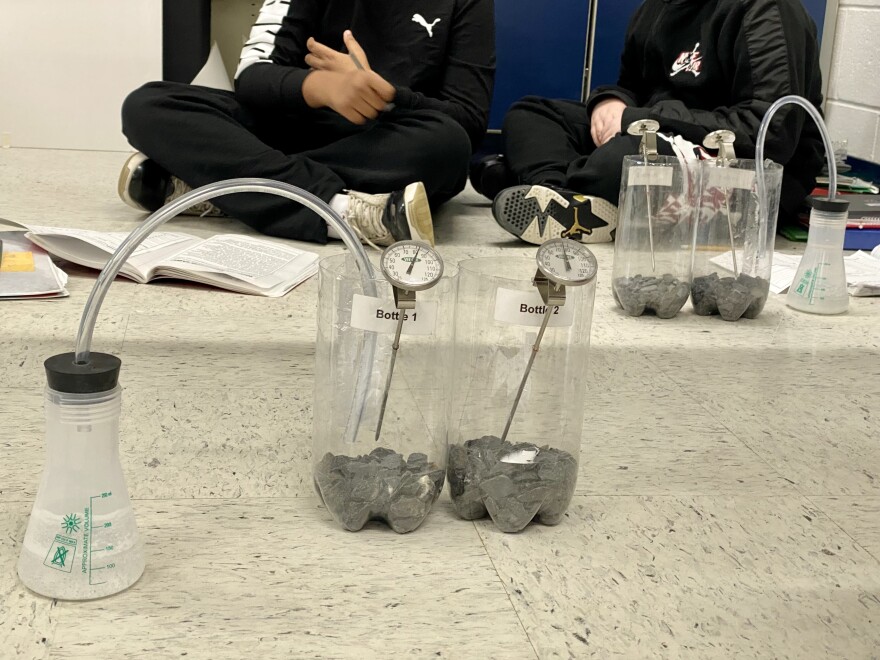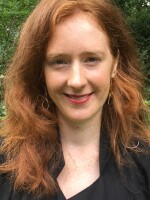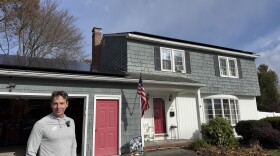A few years ago, Pembroke science teacher Ian West decided he didn’t want to teach his sixth graders about climate change by showing them a graph. He wanted students to understand it for themselves.
He started to implement a curriculum that allows students to see climate change’s impact, one classroom experiment at a time. In one, students drop alka seltzer into bottles of water to release carbon dioxide, which then travels through a tube into a nearby chamber. Before their eyes, the temperature in the nearby chamber increases.

In another, students wrap emissions bags around the tailpipes of cars with different levels of fuel efficiency. Once the cars turn on, students measure how long it takes for the bags to fill up with exhaust.
“Hands-on experiments are the things that all of us remember from school,” said West, who teaches at Three Rivers School. “If the learning can really be embedded in that activity, there’s a much better chance they’re going to remember that down the line.”
Most people in New Hampshire know that climate change is happening, mainly caused by humans.
And the state has adopted school science standards that include guidance to teach about climate change. But many people – including kids whose lives will be shaped by climate change – don’t understand the science behind it, nor what they can do to mitigate it. Teachers like West are hoping to change that.
After finishing up the experiment with Alka Seltzer, West’s students plot a line graph — showing the relationship between carbon dioxide and rising temperatures, based on their data. Emmah Kuhlman, 11, said she’s starting to grasp why more greenhouse gasses in the atmosphere means warmer winters.
“It makes me feel curious if there is going to be no snow,” she said. “It makes me sad because I do really like snow,” she said.
Snow activities bring joy and essential economic activity to winters here. But as winters warm, communities are having to cancel traditions like ice hockey and pond parties, and without aggressive action on climate change, projections show most downhill ski resorts here could shut down in these kids’ lifetimes.
West tries to steer clear of political discussions in his classroom. But once students start learning about climate change, they often ask what adults and elected leaders are doing to address it.
“It’s difficult to stand in front of 11-year-olds and say that there are grown adults that do not acknowledge really fundamental basic science,” West said.
This grim reality can be overwhelming to students. But among teachers, there is growing interest to make lessons about climate change age-appropriate and fun.
One of the organizations spearheading these efforts is the New Hampshire Energy Education Project (NHEEP). Over the past five years, NHEEP has worked with 600 teachers to expand curriculum and training for lessons related to energy, climate change, and conservation.
Teachers trained by NHEEP connect global climate change to phenomena in students’ backyards. Elementary schoolers learn about the relationship between a warmer, wetter climate and the puddles messing up their playground. And high schoolers connect the relationship between fossil fuels, a warming planet and the local increase in ticks carrying Lyme disease.

Ian West, who has done extensive training with NHEEP and its partner organization in Vermont, VEEP, said even though the lessons are about energy, climate change and fossil fuels, the lessons are designed to develop skills applicable to most subjects.
“I really need students to develop those critical thinking skills, those graphing skills, those engineering skills,” he said.
Aubrey Nelson, an educator with NHEEP, said a big part of their approach is teaching students about solutions too. At the end of a workshop or lesson, they often refer students to Project Drawdown, an analysis that helps people measure the efficacy of different climate solutions, including small-scale changes like recycling, going vegetarian, and using LED lights.
“If they are figuring out what kinds of things make a difference and why, they’re more likely to be engaged in their communities and doing things,” she explained. “If you're just burdened with the climate science, the opposite tends to happen in that kids go into a state of denial and are like: ‘This is bigger than me; there’s nothing I can do about it.’”
NHEEP is explicit about wanting students to engage in their communities and promote sustainability. Nelson says once they dig into policy decisions, students’ work can get political. But the lesson plans shouldn’t be.
“If we're making evidence-based decisions and the evidence overwhelmingly shows that this is a problem, it's not really a partisan conversation,” she said. ”The kids are doing the science to figure out what's going on.”
The transition from science lessons to civic engagement is on full display at White Mountains Regional High School in Whitefield. The school hosts workshops with NHEEP and houses a Career and Technical program where students can learn about environmental and sustainable sciences. Last year, members of the school’s sustainability club won a $107,000 grant to help the school switch to energy-efficient LED lights. This year, they’re working on a compost and recycling campaign.

Much of the students’ work has involved educating their peers about energy and conservation, which junior Victoria Whitcomb says is missing from most classes prior to high school.
“It’s kind of general ignorance in society,” she said. “We know this is a problem, it’s coming at us slowly, we know it’s going to be a big issue, and we’re not really doing much about it.”
Sophomore Yonah Friedman, another member of the sustainability club, said pushing the school to examine its environmental impact has mitigated some of the despair she feels when she reads the news.
“You should be scared about this to an extent. But I think a lot of it has just become this overwhelming sort of big beast that we have to tackle,” she said.
Senior Justin Wentworth says taking environmental science last year changed his life.
“I have this desire in me to make a difference. I didn't know where, but it was just like a need, like: ‘I need to do something big,’” Wentworth said.

After making the connection between energy production and climate change, Wentworth joined the sustainability club. This year, he applied for colleges in pursuit of a degree and career in environmental studies.
Aidan Howry, who teaches environmental science and advises the club, has watched other students move from apathy to engagement once they understand how the planet works.
Next year, she is expanding the school’s course offerings, with the goal of giving more students a chance to take environmental science.
“To me, it’s critical that if you’re a high school graduate, you should know how our planet functions and the way we use our planet,” she said. “We need to have that relationship with our planet to keep going into the future.”








